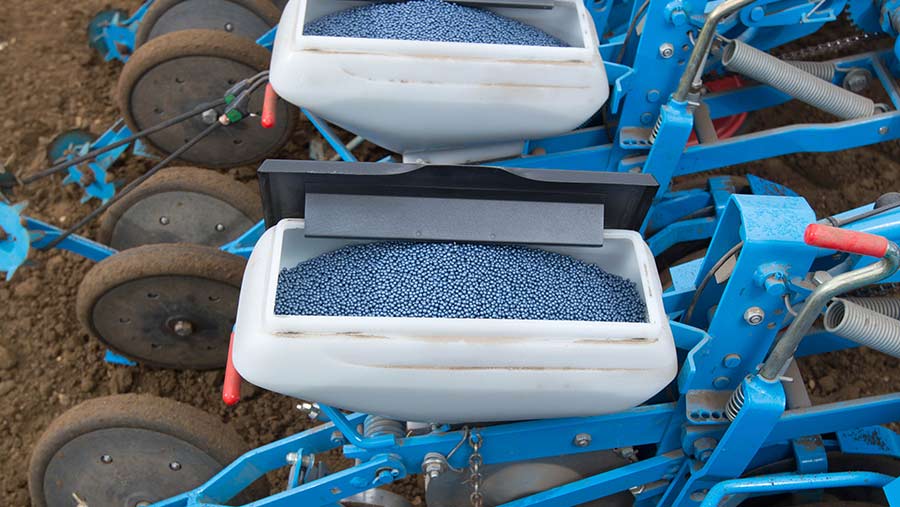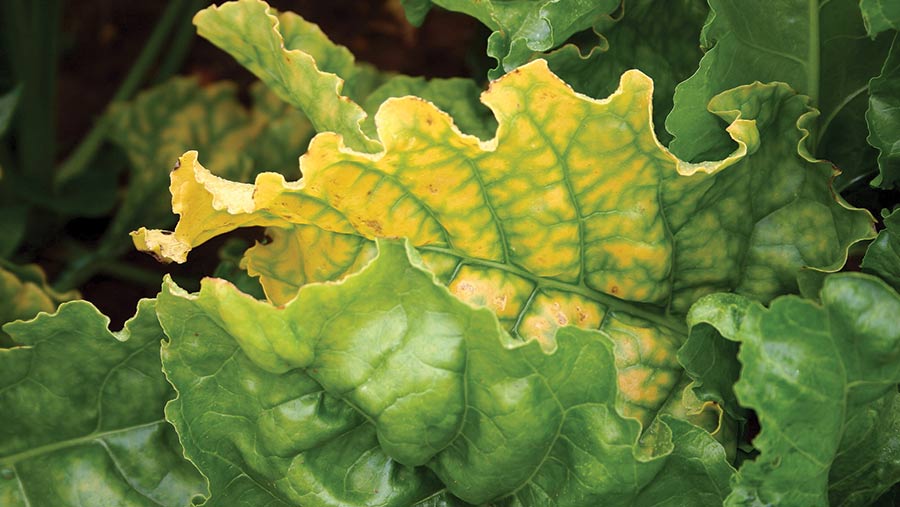What the neonic seed treatment ban means for sugar beet
 © Tim Scrivener
© Tim Scrivener Next year’s sugar beet crop will be at greater risk from virus yellows, due to the loss of seed treatment control measures.
This follows confirmation that the sale and supply of three neonicotinoid seed treatment active ingredients will cease by mid-September, with the use of seed treated with the three actives ending on 19 December.
See also: How to manage disease in sugar beet crops
For sugar beet growers, this means that current choices thiamethoxam and clothianidin can no longer be used in seed treatments for the 2019 crop, after the EU extended the ban from using them on flowering crops to include all outdoor crops.
Imidacloprid, another neonicotinoid active ingredient that had previously been used in sugar beet, is also affected by the decision.
Peach potato aphid
In their absence, beet growers are left without any control measures for the most important vector of virus yellows, the peach potato aphid (Myzus persicae), which has developed resistance to several important insecticide groups, including pyrethroids.
Before the ban extension was announced, the British Beet Research Organisation (BBRO) was already working on alternative strategies for controlling virus-transmitting aphids, as well as other pests controlled by the widely used seed treatments – with that work now taking on greater urgency.
“The UK sugar beet sector was severely challenged in 1987 by rhizomania,” says Dr Mark Stevens, head of science at BBRO.
“At the time, there was plenty of doom and gloom, with some predicting the demise of the crop. That didn’t happen.
“Now we are facing another challenge and we are up for it – there are potential solutions out there and we need to get them fast-tracked.”
The neonicotinoid seed treatments have been an effective one-stop shop, he acknowledges. “Up until now, growers have been able to control 15 pests with their use and they’ve all got used to that convenience. No wonder 97% of the UK crop was treated.”
For some pests, their loss won’t be a problem, as there are actives such as tefluthrin which can still be used in seed treatments, he stresses.
“That’s the case with soil pests, such as millipedes, symphylids and springtails. Tefluthrin, which is found in Force, will give good control.”
Leaf miner
Another pest, leaf miner, is less of a problem due to its sporadic nature, although it does seem to be on the increase, Dr Stevens warns.
“Having said that, 2017 wasn’t a bad year for it, so there was no need for an emergency authorisation for a foliar application of thiacloprid.”
Without foliar thiacloprid, control options for the pest are limited once the neonicotinoid seed treatments have worn off.
“Hallmark can be used but it relies primarily on contact action, so once the larvae have penetrated the leaf, it is difficult to control them. It is a pyrethroid, so it’s not great for beneficials.”
Virus yellows
Virus yellows is the biggest challenge and will require the use of integrated approaches, especially as tolerant varieties are not likely to be available for at least another five years, Dr Stevens says.
“The good news is that there is plenty of plant breeding work being done on developing tolerance, so we are hopeful that resistant varieties will be introduced in due course.”
However, there’s no single major source of resistance, so that work involves identifying lots of minor genes for the three different viruses, he explains.
“It’s complex, which is why these varieties will take a few years to produce. In the meantime, we will have to monitor crops closely and improve surveillance.”
New technology will help with this, he believes, as will greater attention to farm hygiene.
Teppeki clearance
Other insecticides are also of interest, with Dr Stevens highlighting the aphicide known as Teppeki (flonicamid), which is already approved for use in potatoes and cereals.
“It’s a foliar spray and, if it is cleared for use in sugar beet, we will only be allowed to make one application. So timing will be very important,” he says.
“It can give useful activity. A label extension to include sugar beet would be helpful.”
Manufacturer Belchim confirms that it expects Teppeki’s approval for use in sugar beet imminently, with delays looking unlikely.
What is virus yellows?
Virus yellows is caused by a complex of viral agents, including beet mild yellowing virus, beet yellows virus and beet chlorosis virus.
Between 1980 and 1995, losses to virus yellows were estimated at £5.5m a year when older (pre-neonicotinoid) treatments were applied, rising to more than £10m in the absence of control measures.

© Blackthorn Arable
Unchecked, yield losses from virus yellows are estimated to be in the region of 20-25%, with the UK’s maritime climate proving to be ideal for the aphids, which transmit the virus by feeding on the plants. Losses are greatest in years when aphids colonise beet plants early in the spring and multiply rapidly.
Until now, widespread use of neonicotinoid seed treatments has provided excellent control of aphids during the early stages of crop growth, protecting the crop against virus yellows and its associated yield loss.
In 2017, BBRO aphid monitoring saw the first peach potato aphids being caught in May, while the first virus yellows infected plants were found at its demonstration site at Rougham, Suffolk on 16 June.

